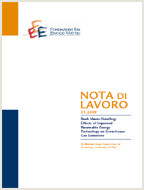Revisiting worst-case DEA for composite indicators

Data
23.02.2015
23.02.2015
Autori
Stergios Athanassoglou (European Commission Joint Research Center)
Codice JEL
C43, C44, Q00
C43, C44, Q00
Parole chiave:
Composite Indicator, Sustainability Index, DEA, Worst-case, Convex Optimization
Composite Indicator, Sustainability Index, DEA, Worst-case, Convex Optimization
Publisher
Climate Change and Sustainable Development
Climate Change and Sustainable Development
Editor
Carlo Carraro
Carlo Carraro
Composite indicators are becoming increasingly infuential tools of environmental assessment and advocacy. Nonetheless, their use is controversial as they often rely on ad-hoc and theoretically problematic assumptions regarding normalization, aggregation, and weighting. Nonparametric data envelopment analysis (DEA) methods, originating in the production economics literature, have been proposed as a means of addressing these concerns. These methods dispense with contentious normalization and weighting techniques by focusing on a measure of best-case relative performance. Recently, the standard DEA model for composite indicators was extended to account for worst-case analysis by Zhou, Ang, and Poh [21] (hereafter, ZAP). In this note we argue that, while valid and interesting in its own right, the measure adopted by ZAP may not capture, in a mathematical as well as practical sense, the notion of worst-case relative performance. By contrast, we focus on the strict worst case analogue of standard DEA for composite indicators and show how it leads to tractable optimization problems. Finally, we compare the two methodologies using data from ZAP’s Sustainable Energy Index case study, demonstrating that they occasionally lead to divergent results.
***
Suggested citation: Athanassoglou, S., (2015), ‘Revisiting Worst-case DEA for Composite Indicators’, Nota di Lavoro 13.2015, Milan, Italy: Fondazione Eni Enrico Mattei.
